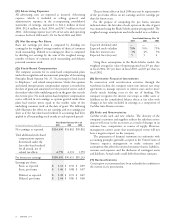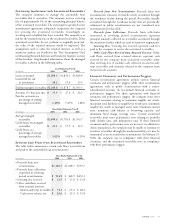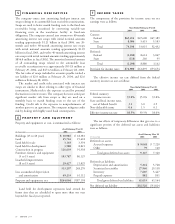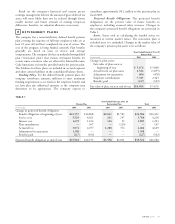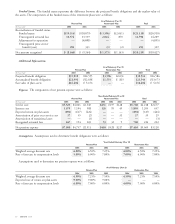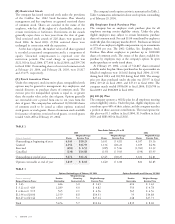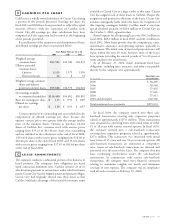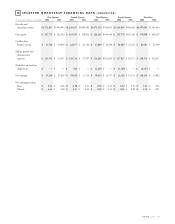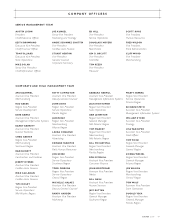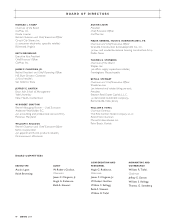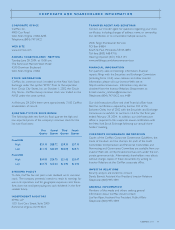CarMax 2004 Annual Report Download - page 46
Download and view the complete annual report
Please find page 46 of the 2004 CarMax annual report below. You can navigate through the pages in the report by either clicking on the pages listed below, or by using the keyword search tool below to find specific information within the annual report.
44
CARMAX
2004
CONTINGENT LIABILITIES
(A) Litigation
In the normal course of business, the company is involved in
various legal proceedings. Based upon the company’s evaluation
of the information presently available, management believes
that the ultimate resolution of any such proceedings will not
have a material adverse effect on the company’s financial
position, liquidity, or results of operations.
(B) Other Matters
In accordance with the terms of real estate lease agreements, the
company generally agrees to indemnify the lessor from certain
liabilities arising as a result of the use of the leased premises,
including environmental liabilities and repairs to leased
property upon termination of the lease. Additionally, in
accordance with the terms of agreements entered into for the
sale of our properties, the company generally agrees to
indemnify the buyer from certain liabilities and costs arising
subsequent to the date of the sale, including environmental
liabilities and liabilities resulting from the breach of
representations or warranties made in accordance with the
agreements. The company does not have any known material
environmental commitments, contingencies, or other
indemnification issues arising from these arrangements.
As part of its customer service strategy, the company
guarantees the vehicles it sells with a 30-day limited warranty. A
vehicle in need of repair within 30 days of the customer’s
purchase will be repaired free of charge. As a result of this
guarantee, each vehicle sold has an implied liability associated
with it. As such, the company records a provision for repairs
during the guarantee period for each vehicle sold based on
historical trends. The liability for this guarantee was $1.4 million
at February 29, 2004, and $1.3 million at February 28, 2003,
and is included in accrued expenses and other current liabilities
in the consolidated balance sheets.
RECENT ACCOUNTING
PRONOUNCEMENTS
In May 2003, the FASB issued SFAS No. 150, “Accounting
for Certain Financial Instruments with Characteristics of
Both Liabilities and Equity.” This statement establishes
standards for how an issuer classifies and measures certain
financial instruments with characteristics of both liabilities
and equity. SFAS No. 150 is effective for financial
instruments entered into or modified after May 31, 2003, and
otherwise is effective at the beginning of the first interim
period beginning after June 15, 2003. The application of the
provisions of SFAS No. 150 has not and is not expected to
have a material impact on the company’s financial position,
results of operations, or cash flows.
14
13
In December 2003, the FASB issued SFAS No. 132 (revised
2003), “Employers’ Disclosures about Pensions and Other
Postretirement Benefits.” This revised statement retains the
disclosures required by the original SFAS No. 132, which
standardized employers’ disclosures about pensions and other
postretirement benefits, and requires additional disclosures
concerning the economic resources and obligations related to
pension plans and other postretirement benefits. The
provisions of the original SFAS No. 132 remain in effect until
the provisions of this revised statement are adopted. This
revised statement is effective for fiscal years ending after
December 15, 2003. The company has revised its disclosures
to meet the requirements under this revised standard for the
financial statements currently presented.
In December 2003, the FASB issued FASB Interpretation
(“FIN”) No. 46 (revised December 2003), “Consolidation of
Variable Interest Entities.” This revised interpretation retains
the original FIN No. 46 requirements for consolidating
variable interest entities by the primary beneficiary of the
entity if the equity investors in the entity do not have the
characteristics of a controlling financial interest or do not have
sufficient equity at risk for the entity to finance its activities
without additional subordinated financial support from other
parties. The revised interpretation adds the requirement for
consolidating an entity where the equity investors’ voting rights
are not proportionate to their economic interests and where the
activities of the entity involve or are conducted on behalf of an
investor with a disproportionately small voting interest. This
revised interpretation is effective for all entities no later than
the end of the first reporting period that ends after March 15,
2004. However, for reporting periods ending after December 15,
2003, a company must apply either the original or this revised
interpretation to those entities that are considered to be special-
purpose entities. A company that has already applied the
original FIN No. 46 to an entity may continue to do so until
the effective date of the revised interpretation. The company
has applied the revised FIN No. 46, which has not had a
material impact on the company’s financial position, results of
operations, or cash flows.


